Conservation and Management of Protected Areas in China and India: A Literature Review (1990–2021)
Abstract
1. Introduction
2. Materials and Methods
2.1. Search Strategy
2.2. Data Collection
2.3. Statistics Analysis
3. Results
3.1. Overall Distribution
3.2. Collaboration
3.3. Keyword Analysis
4. Discussion
5. Conclusions
Supplementary Materials
Author Contributions
Funding
Data Availability Statement
Acknowledgments
Conflicts of Interest
References
- He, M.; Cliquet, A. Challenges for Protected Areas Management in China. Sustainability 2020, 12, 5879. [Google Scholar] [CrossRef]
- Charles, A. Communities, Conservation and Livelihoods; IUCN: Gland, Switzerland, 2021. [Google Scholar]
- Becken, S.; Job, H. Protected Areas in an Era of Global-Local Change. J. Sustain. Tour. 2014, 22, 507–527. [Google Scholar] [CrossRef]
- Bobb-Prescott, N. Case Study on the Use of Participatory Three-Dimensional Modelling to Facilitate Effective Contribution of Civil Society in the Caribbean Islands in Planning for Action on Climate Change; CANARI Technical Report401; CANARI: Laventille, Trinidad and Tobago, 2014. [Google Scholar]
- Apollo, M.; Andreychouk, V.; Mostowska, J.; Rawat, K. Indo-Himalayan Protected Areas: Peak-Hunters, Pilgrims and Mountain Tourism. In Nature-Based Tourism in Asia’s Mountainous Protected Areas; Jones, T.E., Bui, H.T., Apollo, M., Eds.; Geographies of Tourism and Global Change; Springer: Cham, Switzerland, 2021. [Google Scholar] [CrossRef]
- Miller-Rushing, A.J.; Primack, R.B.; Ma, K.; Zhou, Z.Q. A Chinese Approach to Protected Areas: A Case Study Comparison with the United States. Biol. Conserv. 2017, 210, 101–112. [Google Scholar] [CrossRef]
- Pourmajidian, M.; Yousefi Valikchali, M.; Darvishi, L. Protected Areas in the Face of Environmental Challenges. In Proceedings of the Iranian National Conference on Environment and Energy, Shiraz, Iran, 11 August 2014. [Google Scholar]
- Bawa, K.S.; Koh, L.P.; Lee, T.M.; Liu, J.; Ramakrishnan, P.S.; Yu, D.W.; Zhang, Y.P.; Raven, P.H. China, India, and the Environment. Science 2010, 327, 1457–1459. [Google Scholar] [CrossRef] [PubMed]
- Gupta, S. India’s Loss of Biodiversity and Ecological Consequences. Int. J. Res. Appl. Sci. Biotechnol. 2019, 6, 34–38. [Google Scholar]
- Mi, X.; Feng, G.; Hu, Y.; Zhang, J.; Chen, L.; Corlett, R.T.; Hughes, A.C.; Pimm, S.; Schmid, B.; Shi, S.; et al. The Global Significance of Biodiversity Science in China: An Overview. Natl. Sci. Rev. 2021, 8, nwab032. [Google Scholar] [CrossRef]
- Marks, R. China: An Environmental History; Rowman & Littlefield: Lanham, MD, USA, 2017; ISBN 9781442277885. [Google Scholar]
- Liu, J.; Ouyang, Z.; Pimm, S.L.; Raven, P.H.; Wang, X.; Miao, H.; Han, N. Protecting China’s Biodiversity. Science 2003, 300, 1240–1241. [Google Scholar] [CrossRef]
- Venkataraman, K.; Sivaperuman, C. Biodiversity Hotspots in India. In Indian Hotspots: Vertebrate Faunal Diversity, Conservation and Management Volume 1; Springer: Singapore, 2018; pp. 1–27. ISBN 9789811066054. [Google Scholar]
- Leverington, F.; Costa, K.L.; Pavese, H.; Lisle, A.; Hockings, M. A Global Analysis of Protected Area Management Effectiveness. Environ. Manag. 2010, 46, 685–698. [Google Scholar] [CrossRef]
- Bishop, K.; Phillips, A.; Warren, L. Protected for Ever? Factors Shaping the Future of Protected Areas Policy. Land Use Policy 1995, 12, 291–305. [Google Scholar] [CrossRef]
- Mellon, V.; Bramwell, B. Protected Area Policies and Sustainable Tourism: Influences, Relationships and Co-Evolution. J. Sustain. Tour. 2016, 24, 1369–1386. [Google Scholar] [CrossRef]
- Huang, Y.; Fu, J.; Wang, W.; Li, J. Development of China’s Nature Reserves over the Past 60 Years: An Overview. Land Use Policy 2019, 80, 224–232. [Google Scholar] [CrossRef]
- Zhao, W. Beginning: China’s National Parks System. Natl. Sci. Rev. 2022, 9, nwac150. [Google Scholar] [CrossRef] [PubMed]
- Wei, D.; Luo, Z.; Li, J.; Wang, W.; Zhang, M. Assessing the Effectiveness of Protecting Reserves for Nature Assets in China. J. Geogr. Sci. 2015, 25, 417–427. [Google Scholar] [CrossRef]
- Ghosh-Harihar, M.; An, R.; Athreya, R.; Borthakur, U.; Chanchani, P.; Chetry, D.; Datta, A.; Harihar, A.; Karanth, K.K.; Mariyam, D.; et al. Protected Areas and Biodiversity Conservation in India. Biol. Conserv. 2019, 237, 114–124. [Google Scholar] [CrossRef]
- Sarangi, T.K. The Forest Rights Act 2006 in Protected Areas of Odisha, India: Contextualizing the Conflict between Conservation and Livelihood. Asia Pacific J. Environ. Law 2017, 20, 180–205. [Google Scholar] [CrossRef]
- Moed, H.F. Bibliometric Indicators Reflect Publication and Management Strategies. Scientometrics 2000, 47, 323–346. [Google Scholar] [CrossRef]
- Keathley-Herring, H.; Van Aken, E.; Gonzalez-Aleu, F.; Deschamps, F.; Letens, G.; Orlandini, P.C. Assessing the Maturity of a Research Area: Bibliometric Review and Proposed Framework. Scientometrics 2016, 109, 927–951. [Google Scholar] [CrossRef]
- Moro, A.; Boelman, E.; Joanny, G.; Lopez-Garcia, J. A Bibliometric-Based Technique to Identify Emerging Photovoltaic Technologies in a Comparative Assessment with Expert Review. Renew. Energy 2018, 123, 407–416. [Google Scholar] [CrossRef]
- Aghaei Chadegani, A.; Salehi, H.; Md Yunus, M.M.; Farhadi, H.; Fooladi, M.; Farhadi, M.; Ale Ebrahim, N. A Comparison between Two Main Academic Literature Collections: Web of Science and Scopus Databases. Asian Soc. Sci. 2013, 9, 18–26. [Google Scholar] [CrossRef]
- Singh, V.K.; Singh, P.; Karmakar, M.; Leta, J.; Mayr, P. The Journal Coverage of Web of Science, Scopus and Dimensions: A Comparative Analysis. Scientometrics 2021, 126, 5113–5142. [Google Scholar] [CrossRef]
- Chen, C. CiteSpace II: Detecting and Visualizing Emerging Trends and Transient Patterns in Scientific Literature. J. Am. Soc. Inf. Sci. Technol. 2006, 57, 359–377. [Google Scholar] [CrossRef]
- van Eck, N.J.; Waltman, L. Software Survey: VOSviewer, a Computer Program for Bibliometric Mapping. Scientometrics 2010, 84, 523–538. [Google Scholar] [CrossRef]
- Aria, M.; Cuccurullo, C. Bibliometrix: An R-Tool for Comprehensive Science Mapping Analysis. J. Informetr. 2017, 11, 959–975. [Google Scholar] [CrossRef]
- Agarwal, A.; Durairajanayagam, D.; Tatagari, S.; Esteves, S.C.; Harlev, A.; Henkel, R.; Roychoudhury, S.; Homa, S.; Puchalt, N.G.; Ramasamy, R.; et al. Bibliometrics: Tracking Research Impact by Selecting the Appropriate Metrics. Asian J. Androl. 2016, 18, 296–309. [Google Scholar] [CrossRef]
- Hirsch, J.E. An Index to Quantify an Individual’s Scientific Research Output. Proc. Natl. Acad. Sci. USA 2005, 102, 16569–16572. [Google Scholar] [CrossRef] [PubMed]
- Leydesdorff, L.; Wagner, C.S. International Collaboration in Science and the Formation of a Core Group. J. Informetr. 2008, 2, 317–325. [Google Scholar] [CrossRef]
- Yu, D.; Xu, Z.; Fujita, H. Bibliometric Analysis on the Evolution of Applied Intelligence. Appl. Intell. 2019, 49, 449–462. [Google Scholar] [CrossRef]
- Wang, X.; Xu, Z.; Qin, Y. Structure, Trend and Prospect of Operational Research: A Scientific Analysis for Publications from 1952 to 2020 Included in Web of Science Database. Fuzzy Optim. Decis. Mak. 2022, 21, 649–672. [Google Scholar] [CrossRef]
- Wang, L.; Zhang, G.; Wang, Z.; Liu, J.; Shang, J.; Liang, L. Bibliometric Analysis of Remote Sensing Research Trend in Crop Growth Monitoring: A Case Study in China. Remote Sens. 2019, 11, 809. [Google Scholar] [CrossRef]
- Watson, J.E.M.; Dudley, N.; Segan, D.B.; Hockings, M. The Performance and Potential of Protected Areas. Nature 2014, 515, 67–73. [Google Scholar] [CrossRef]
- Mora, C.; Sale, P.F. Ongoing Global Biodiversity Loss and the Need to Move beyond Protected Areas: A Review of the Technical and Practical Shortcomings of Protected Areas on Land and Sea. Mar. Ecol. Prog. Ser. 2011, 434, 251–266. [Google Scholar] [CrossRef]
- Weaver, D.B.; Lawton, L.J. A New Visitation Paradigm for Protected Areas. Tour. Manag. 2017, 60, 140–146. [Google Scholar] [CrossRef]
- Breu, T.; Bergöö, M.; Ebneter, L.; Pham-Truffert, M.; Bieri, S.; Messerli, P.; Ott, C.; Bader, C. Where to Begin? Defining National Strategies for Implementing the 2030 Agenda: The Case of Switzerland. Sustain. Sci. 2021, 16, 183–201. [Google Scholar] [CrossRef]
- Phillips, A. The History of the International System of Protected Area Management Categories. Int. J. Prot. Area Manag. 2004, 14, 2–14. [Google Scholar]
- Reich, M.R.; Bowonder, B. Environmental Policy in India: Strategies for Better Implementation. Policy Stud. J. 1992, 20, 643–661. [Google Scholar] [CrossRef]
- Chandrakar, A.K. Biodiversity Conservation in India; Central University of Gujarat: Gandhinagar, India, 2012. [Google Scholar]
- Karanth, K.K. Making Resettlement Work: The Case of India’s Bhadra Wildlife Sanctuary. Biol. Conserv. 2007, 139, 315–324. [Google Scholar] [CrossRef]
- Marcot, B.G. Conservation of Indian Forests. Conserv. Biol. 1992, 6, 12–16. [Google Scholar] [CrossRef]
- Badola, R. People and Protected Areas in India. Unasylva 1999, 50, 12–15. [Google Scholar]
- Hundal, S. Wild Life Conservation Strategies and Management in India: An Overview. In Proceedings of the Species at Risk 2004: Pathways to Recovery Conference, Victoria, BC, Canada, 3 March 2004. [Google Scholar]
- Bawa, K.S.; Rai, N.D.; Sodhi, N.S. Rights, Governance, and Conservation of Biological Diversity. Conserv. Biol. 2011, 25, 639–641. [Google Scholar] [CrossRef]
- Torri, M.C. Conservation, Relocation and the Social Consequences of Conservation Policies in Protected Areas: Case Study of the Sariska Tiger Reserve, India. Conserv. Soc. 2011, 9, 54–64. [Google Scholar] [CrossRef]
- Gupta, V. Sustainable Tourism: Learning from Indian Religious Traditions. Int. J. Contemp. Hosp. Manag. 1999, 11, 91–95. [Google Scholar] [CrossRef]
- Margulies, J.D.; Karanth, K.K. The Production of Human-Wildlife Conflict: A Political Animal Geography of Encounter. Geoforum 2018, 95, 153–164. [Google Scholar] [CrossRef]
- Igoe, J.; Croucher, B. Conservation, Commerce, and Communities: The Story of Community-Based Wildlife Management Areas in Tanzania’s Northern Tourist Circuit. Conserv. Soc. 2007, 5, 534–561. [Google Scholar]
- Rain, D.R.; Long, J.F.; Ratcliffe, M.R. Measuring Population Pressure on the Landscape: Comparative GIS Studies in China, India, and the United States. Popul. Environ. 2007, 28, 321–336. [Google Scholar] [CrossRef]
- Pereira, W.; Seabrook, J. Asking the Earth: Farms, Forestry and Survival in India; Earthscan Ltd.: London, UK, 2013; Volume 5, pp. 1–228. [Google Scholar] [CrossRef]
- Sahu, G. Implementation of the Scheduled Tribes and Other Traditional Forest Dwellers (Recognition of Rights) Act 2006 in Jharkhand: Problems and Challenges. J. L. Rural Stud. 2021, 9, 158–177. [Google Scholar] [CrossRef]
- Wang, G.; Innes, J.L.; Lei, J.; Dai, S.; Wu, S.W. Ecology: China’s Forestry Reforms. Science 2007, 318, 1556–1557. [Google Scholar] [CrossRef] [PubMed]
- Jinping, X. Secure a Decisive Victory in Building a Moderately Prosperous Society in All Respects and Strive for the Great Success of Socialism with Chinese Characteristics for a New Era. In Proceedings of the 19th National Congress of the Communist Party of China, Beijing, China, 18–24 October 2017; Volume 18, pp. 2011–2017. [Google Scholar]
- Zhang, L.; Luo, Z.; Mallon, D.; Li, C.; Jiang, Z. Biodiversity Conservation Status in China’s Growing Protected Areas. Biol. Conserv. 2017, 210, 89–100. [Google Scholar] [CrossRef]
- Xu, W.; Pimm, S.L.; Du, A.; Su, Y.; Fan, X.; An, L.; Liu, J.; Ouyang, Z. Transforming Protected Area Management in China. Trends Ecol. Evol. 2019, 34, 762–766. [Google Scholar] [CrossRef]
- Peng, F.W.; Li, J.S.; Yuan, H.; Zhu, Y.P.; Li, B.Y. Research on Overall Scheme of Establishing National Park System; China Environment Publishing Group: Beijing, China, 2019. [Google Scholar]
- Wang, W.; Feng, C.; Liu, F.; Li, J. Biodiversity Conservation in China: A Review of Recent Studies and Practices. Environ. Sci. Ecotechnology 2020, 2, 100025. [Google Scholar] [CrossRef]
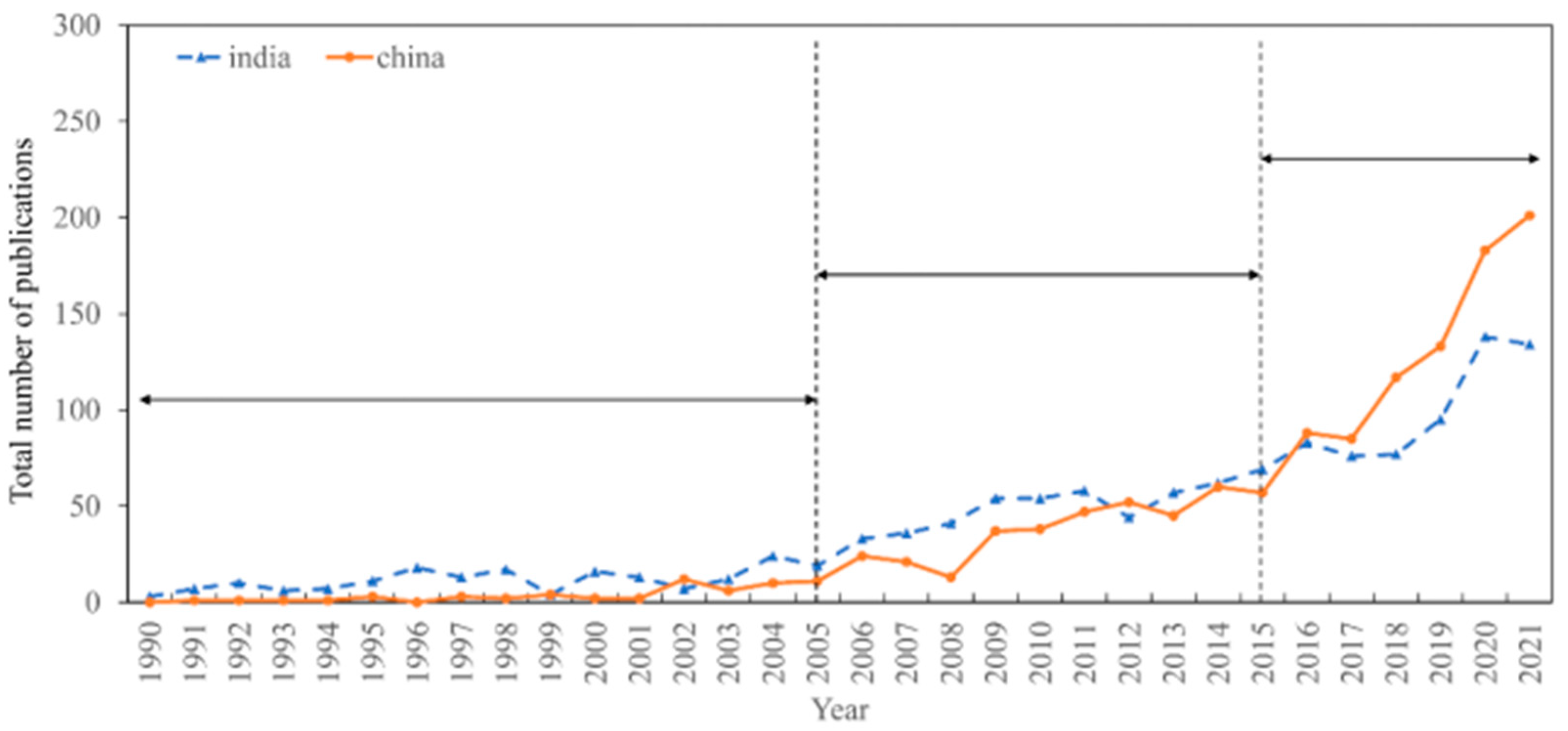


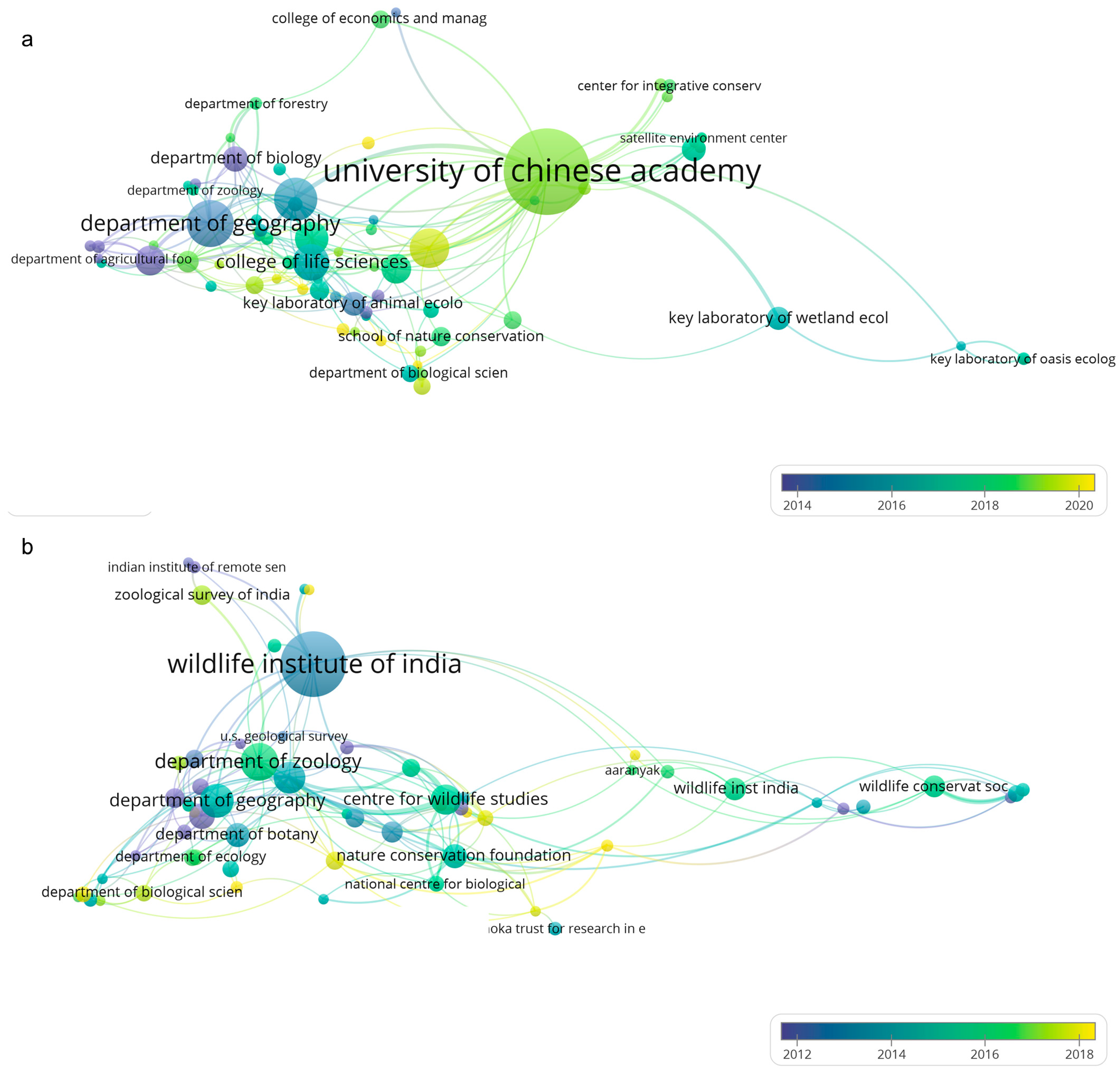
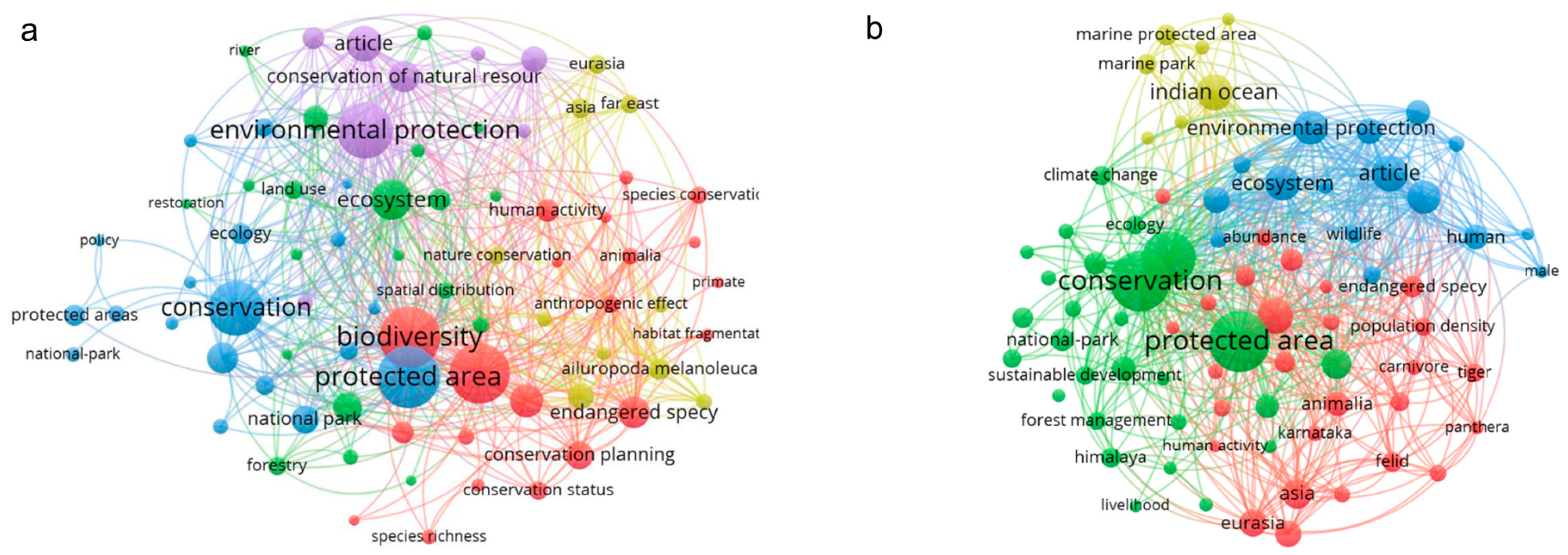

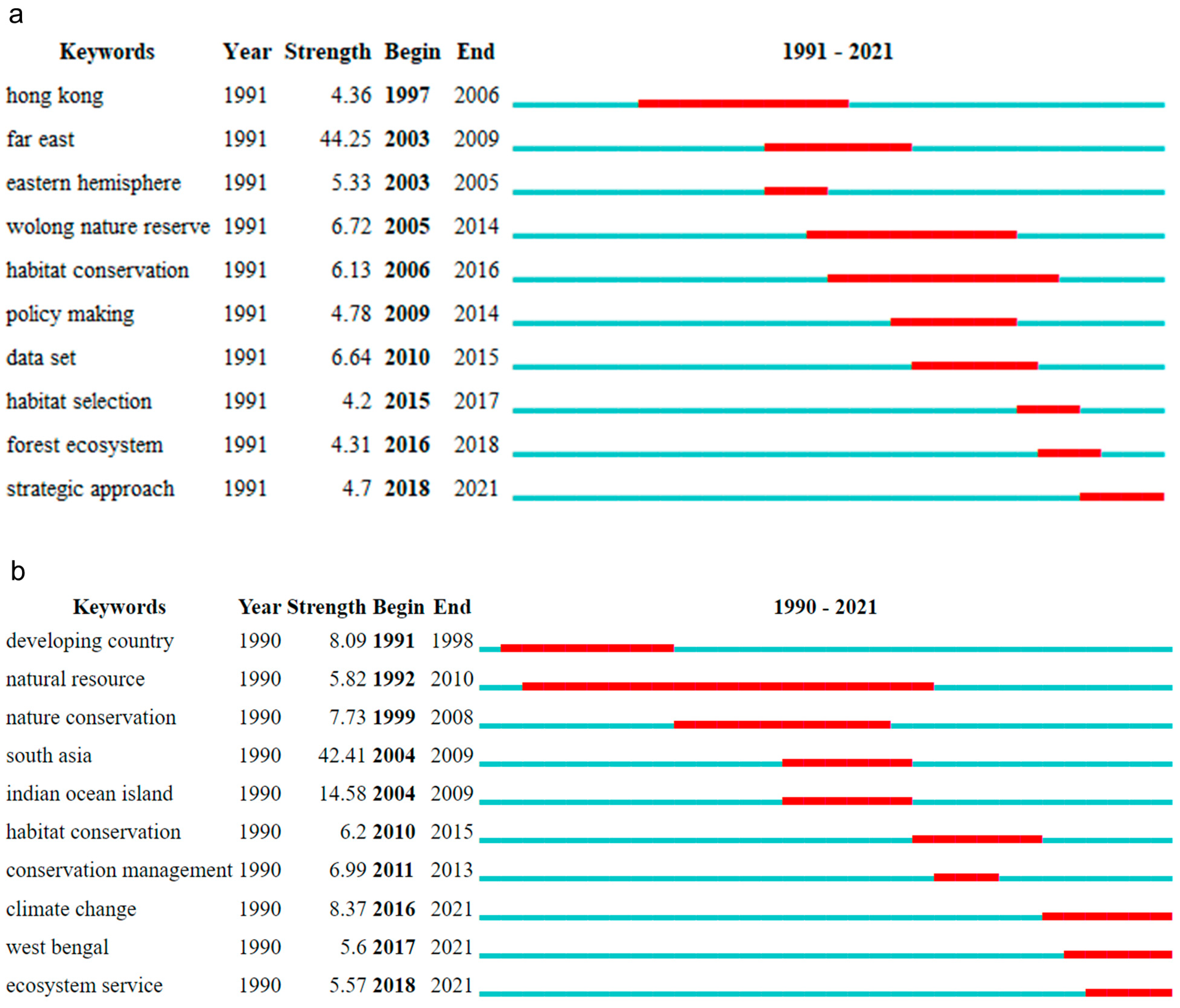

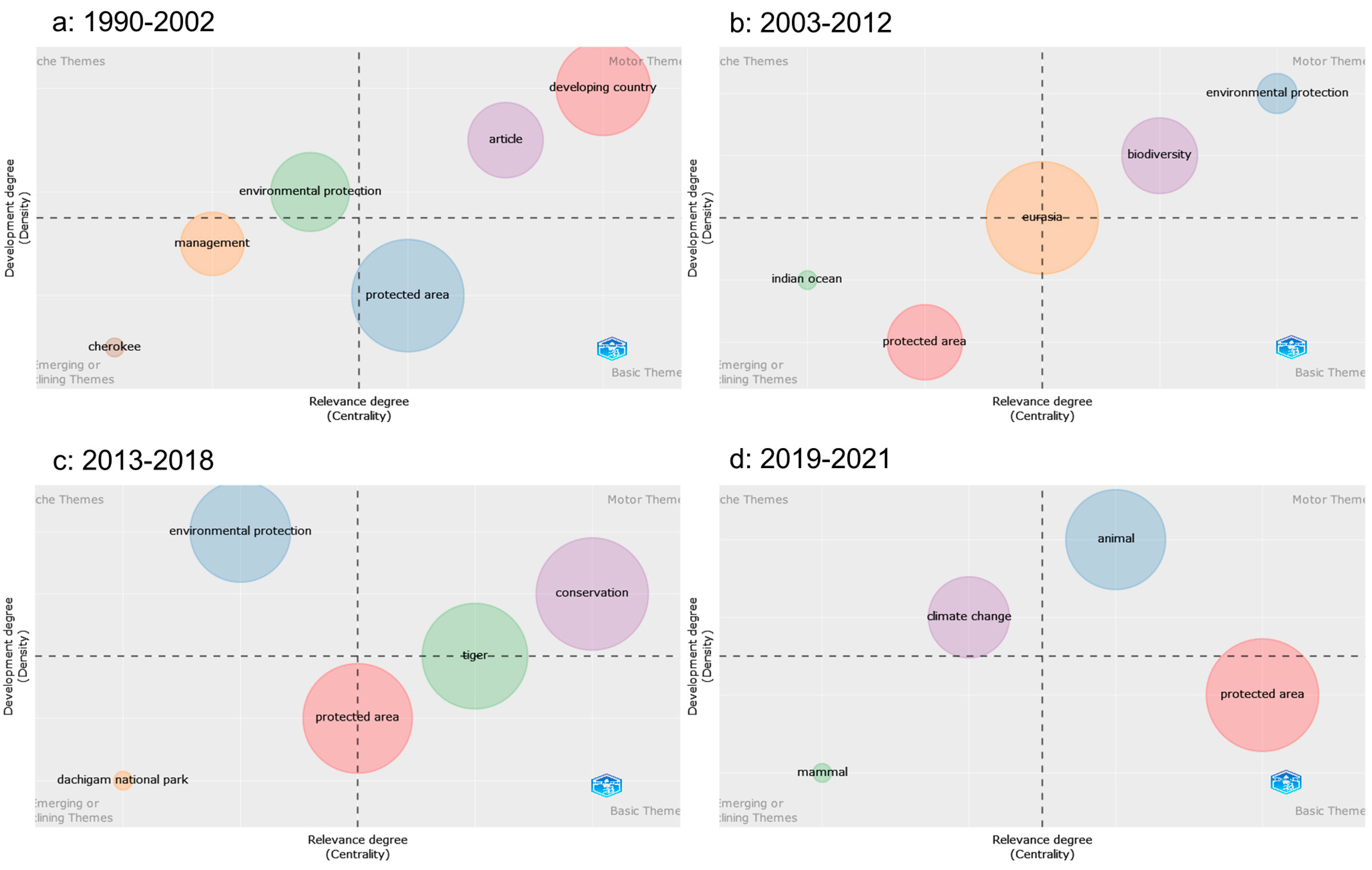

| Country | Database | Type of Dataset | Time Period/Timespan | Search Terms | Total No. of Publications |
|---|---|---|---|---|---|
| India | WoSCC and Scopus | Published and research articles | 1 January 1990–31 December 2021 | National park/protected area/nature reserve/tiger reserve/wildlife sanctuary AND policy/approach/strategy/program/guideline | 1301 |
| China | WoSCC and Scopus | Published and research articles | 1 January 1990–31 December 2021 | National park/protected area/nature reserve/panda reserve/wildlife sanctuary AND policy/approach/strategy/program/guideline | 1263 |
Disclaimer/Publisher’s Note: The statements, opinions and data contained in all publications are solely those of the individual author(s) and contributor(s) and not of MDPI and/or the editor(s). MDPI and/or the editor(s) disclaim responsibility for any injury to people or property resulting from any ideas, methods, instructions or products referred to in the content. |
© 2023 by the authors. Licensee MDPI, Basel, Switzerland. This article is an open access article distributed under the terms and conditions of the Creative Commons Attribution (CC BY) license (https://creativecommons.org/licenses/by/4.0/).
Share and Cite
Gao, W.; Huang, J.; Qiu, Q.; Shrestha, A.; Yuan, C.; Anand, S.; Wang, G.; Wang, G. Conservation and Management of Protected Areas in China and India: A Literature Review (1990–2021). Climate 2023, 11, 22. https://doi.org/10.3390/cli11010022
Gao W, Huang J, Qiu Q, Shrestha A, Yuan C, Anand S, Wang G, Wang G. Conservation and Management of Protected Areas in China and India: A Literature Review (1990–2021). Climate. 2023; 11(1):22. https://doi.org/10.3390/cli11010022
Chicago/Turabian StyleGao, Wen, Jiefan Huang, Quan Qiu, Anil Shrestha, Changyan Yuan, Subhash Anand, Guibin Wang, and Guangyu Wang. 2023. "Conservation and Management of Protected Areas in China and India: A Literature Review (1990–2021)" Climate 11, no. 1: 22. https://doi.org/10.3390/cli11010022
APA StyleGao, W., Huang, J., Qiu, Q., Shrestha, A., Yuan, C., Anand, S., Wang, G., & Wang, G. (2023). Conservation and Management of Protected Areas in China and India: A Literature Review (1990–2021). Climate, 11(1), 22. https://doi.org/10.3390/cli11010022







